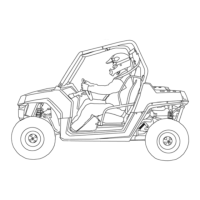ELECTRICAL 5 - 26
November 2007 GEM Service Manual
CLEANING
After time batteries, attract dust, dirt, and grime. In
addition, electrolyte expelled from the battery vent
caps due to over-watering and/or overcharging can
form a conductive path that will cause the batteries
to discharge. Keeping them clean will help one spot
trouble signs if they appear and avoid problems
associated with grime.
CAUTION: When cleaning, do not allow any
cleaning solution, or other foreign matter to get
inside the battery.
1. Check that all vent caps are tightly in place.
2. Clean the battery top with a cloth or brush and
a solution of baking soda and water.
3. Rinse with water and dry with a clean cloth.
4. Clean battery terminals and the inside of cable
clamps using a post and clamp cleaner.
5. Clean terminals will have a bright metallic
shine.
6. Reconnect the clamps to the terminals and
thinly coat them with battery terminal protectant.
7. Keep the area around the battery clean and dry.
CAUTION: Never hose the batteries down with
tap water. The sulfuric acid content of the
electrolyte will spread to other surfaces and
cause corrosive damage.
WARNING: NEVER ADD ACID TO A BATTERY.
STORAGE
Periods of inactivity can be extremely harmful to
lead-acid batteries. When placing a battery into
storage, follow the recommendations below to
make sure that the battery remains healthy and
ready for use.
NOTE: Storing, charging or operating batteries
on concrete is perfectly OK.
SMC – STORAGE MARTS CYCLE
NOTE: Your GEM is equipped with a SMART
charge capability. Simply leave the vehicle
plugged into a standard 110 VAC 15 A power
outlet. The charger unit will automatically power
on once every 2 weeks for gel batteries and
once every 7 days for flooded, run a charge
cycle and automatically shut down. The charger
will repeat this procedure 24 times as long as
power is not interrupted. This works best for
maintenance free sealed gel batteries. Water
filled lead acid batteries may still require some
attention to maintain proper fluid levels.
AVOID TEMPERATURE EXTREMES WHEN
CHOOSING A STORAGE AREA:
1. Avoid locations where freezing temperature is
expected. Keeping battery at a high state of
charge will also prevent freezing. Freezing
results in irreparable damage to battery's plates
and container.
2. Avoid direct exposure to heat sources, such as
radiators or space heaters. Temperatures
above 80° F accelerate the battery's self-
discharge characteristics.
STEP-BY-STEP STORAGE PROCEDURE:
1. Completely charge the battery before storing.
2. Store the vehicle in a cool, dry location,
protected from the elements.
3. During storage, monitor the specific gravity or
voltage. Batteries in storage should be given a
boost charge when they show a 70% charge or
less. See Table 1.
4. Completely charge the battery before
reactivating.
5. For optimum performance, equalize the
batteries before putting them back into service.

